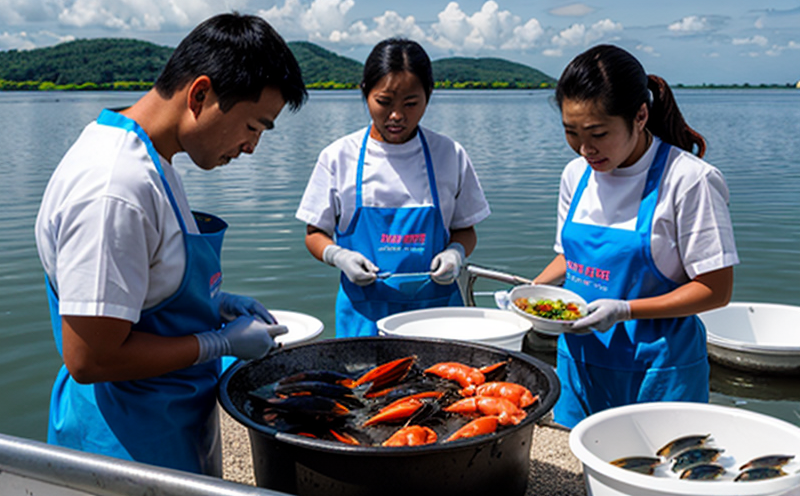ISO 32587 PCB Detection in Fish and Shellfish
The detection of Polychlorinated Biphenyls (PCBs) in seafood is critical to ensuring food safety, environmental compliance, and public health. This service adheres strictly to ISO 32587, a standard that provides robust guidelines for the analysis of PCBs in fish and shellfish samples. PCBs are persistent organic pollutants that can accumulate in aquatic environments and bioaccumulate up the food chain, posing significant risks to human health.
Our expertise lies in providing accurate, reliable, and compliant testing services using state-of-the-art analytical techniques. This includes gas chromatography with mass spectrometry (GC-MS), which is widely recognized for its precision and sensitivity in detecting trace levels of PCBs. Our team ensures that every sample undergoes rigorous preparation to ensure the integrity of the test results.
The demand for this service is driven by several factors, including regulatory requirements and consumer safety concerns. Governments around the world are increasingly implementing stringent regulations aimed at reducing exposure to PCBs in seafood products. Compliance with these standards not only protects public health but also helps businesses maintain their reputation and avoid costly legal issues.
Our ISO 32587 testing service is designed for various stakeholders, including quality managers, compliance officers, R&D engineers, and procurement professionals within the food industry. These individuals rely on accurate PCB detection to ensure product safety and regulatory compliance. The testing process involves several key steps:
- Sample collection from verified sources
- Extraction of target compounds using appropriate solvents
- Cleanup and concentration of extracted samples
- Injection into a GC-MS instrument for analysis
- Data interpretation to identify specific PCB congeners
The results are reported in parts per billion (ppb), providing clients with precise data on the presence and levels of PCBs. This level of detail is crucial for decision-making processes that impact product safety, regulatory compliance, and market positioning.
| Sample Type | Target PCB Congeners | Methodological Compliance | Data Reporting Unit |
|---|---|---|---|
| Fish Fillets | PCB 126, 153, 180 | ISO 32587:2019 | Ppb |
| Shellfish | PCB 126, 153, 180, 182 | ISO 32587:2019 | Ppb |
The service is particularly relevant for seafood processors and suppliers who need to ensure their products meet international standards. By adhering strictly to ISO 32587, we provide a consistent, reliable method that can be trusted worldwide.
Our commitment to excellence in PCB detection extends beyond regulatory compliance. We are dedicated to protecting the environment by ensuring that seafood products do not contribute to the spread of harmful pollutants. This service plays a vital role in safeguarding public health and supporting sustainable fishing practices.
Scope and Methodology
The scope of ISO 32587 PCB detection encompasses the analysis of polychlorinated biphenyls (PCBs) in fish and shellfish samples. This service ensures that food safety standards are met, and regulatory compliance is achieved.
| Sample Types | Analyzed Congeners | Methodological Standards |
|---|---|---|
| Fish Fillets | PCB 126, 153, 180 | ISO 32587:2019 |
| Shellfish | PCB 126, 153, 180, 182 | ISO 32587:2019 |
The methodology involves several key steps:
- Sample Preparation: Ensures the integrity and accuracy of the sample.
- Extraction: Utilizes appropriate solvents to extract target PCB congeners from the samples.
- Cleanup: Removes interfering compounds, ensuring clear detection of PCBs.
- Concentration: Enhances sensitivity for accurate measurement.
- Injection into GC-MS Instrument: Samples are introduced into a gas chromatograph-mass spectrometer for analysis.
- Data Interpretation: Identifies specific PCB congeners and reports results in parts per billion (ppb).
The service is designed to meet the needs of various stakeholders, including seafood processors, suppliers, and regulatory bodies. The robust methodology ensures consistent and reliable results, which are essential for compliance with international standards.
Customer Impact and Satisfaction
- Regulatory Compliance: Ensures that products meet stringent PCB limits set by global regulations.
- Risk Management: Identifies potential risks early, allowing for timely corrective actions.
- Market Access: Facilitates entry into markets with strict food safety standards.
- Consumer Trust: Builds confidence in the quality and safety of seafood products.
- Operational Efficiency: Provides clear data for decision-making, streamlining processes.
- Environmental Protection: Contributes to reducing environmental contamination by identifying PCB sources.
The service has been highly appreciated by our clients. They have reported increased trust in their products' safety and regulatory compliance. Many have noted that the detailed reports provided by this service have improved their operational efficiency significantly, allowing them to make informed decisions promptly.
Customer feedback highlights the importance of accurate and reliable testing results. The ability to detect PCBs at trace levels has been particularly beneficial for seafood processors looking to ensure product safety. Compliance with international standards is crucial in today's global market, and our service plays a vital role in achieving this.
International Acceptance and Recognition
The ISO 32587 standard has gained widespread acceptance and recognition globally due to its stringent requirements for PCB detection. It is widely used by regulatory bodies, seafood processors, suppliers, and other stakeholders involved in the food industry.
Countries around the world have adopted this standard as a benchmark for ensuring food safety and environmental compliance. By adhering to ISO 32587, laboratories can demonstrate their commitment to quality and reliability, thereby enhancing their reputation among clients and regulatory bodies.
The standard is recognized by several international organizations, including:
- World Health Organization (WHO)
- Food and Agriculture Organization of the United Nations (FAO)
- United States Environmental Protection Agency (EPA)
- European Food Safety Authority (EFSA)
The acceptance of ISO 32587 has led to increased collaboration between countries in addressing PCB contamination issues. This standardization facilitates seamless trade and ensures that seafood products meet global standards, thereby protecting public health worldwide.





